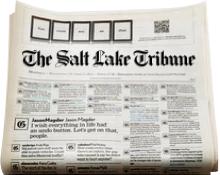This is an archived article that was published on sltrib.com in 2009, and information in the article may be outdated. It is provided only for personal research purposes and may not be reprinted.
Kanab » Kane County Commissioner Mark Habbeshaw told a group of ATV riders Saturday: "We're mad as hell and aren't going to take [it] anymore."
His remark was met with cheers from more than 300 all-terrain and off-highway vehicle owners at a rally outside Kanab before the group got the command, "Let's ride." They went en masse out to the Paria River to ride their machines up the muddy stream in a protest over federal restrictions on use.
The protesters said they wanted to let federal land managers and environmentalists know that area residents have a stake in who controls roads on the Grand Staircase-Escalante National Monument, which is managed by the Bureau of Land Management out of Kanab.
Organizer Shawna Cox said the rally was called to protest Congress' usurpation of states' rights.
"People are the government," she said, dressed in a vest of the U.S. flag. "We need to go back to the Constitution. ... We're standing up for our rights to access."
The BLM's transportation management plan for the 1.9-million acre monument does not list the river, that meanders through the Paria-Hackberry Wilderness Study Area, as a road, meaning it is closed to motorized vehicles.
Last month, the 10th U.S. Circuit Court of Appeals turned back a county lawsuit and upheld the BLM's transportation plan for the monument. In the past, the BLM did not enforce the policy but depended instead on voluntary compliance.
Saturday was no exception as law enforcement stood by just watching the vehicles plow through the shallow stream.
BLM spokesman Larry Crutchfield said Saturday that it is critical for everyone to respect the law and legal process. He said there are 600 miles of roads in the monument open to ATV and OHV use.
"The BLM will enforce the monument travel plan, which is designed to protect monument resources and also ensure that designated routes remain open for use," Crutchfield said.
The crowd shouted its approval when speakers criticized the BLM and claimed that The Salt Lake Tribune distorts facts in favor of government and environmentalists.
Habbeshaw said federal court rulings against the county in lawsuits challenging the ownership of roads are "not right" and subvert the intent of Congress when it passed RS2477, a Civil-War era law that allowed roads to be built across federal lands to encourage development of the West.
The law was amended in 1976 to halt construction of new roads but it recognized existing roads owned by counties or states.
The courts have ruled that disputed RS2477 claims have to be adjudicated to prove they met the requirements of a road.
Habbeshaw said the county has now sued the federal government for quiet-title to 12 roads with the lawsuits costing it millions of dollars.
Rep. Mike Noel, R-Kanab, fired-up the crowd when he said that after the roads are taken away by the government, they will come after the people's right to hunt on public lands.
He also criticized the relationship between the BLM, environmental groups and news media, claiming the they want to make the monument and other western public lands a "playground for the East."
After arriving at the river, the riders were greeted by a small group of counter demonstrators who took pictures, had refreshments and stood in the cool water as they watched the mechanical parade roll upstream.
Kanab resident Sky Cheney, who has criticized the cost of the county's road policy, said he was concerned the ride would lead to more expensive litigation.
"This is obviously not a good route to contest," Cheney said.
Wayne Hoskisson, the chairman of the Utah chapter of the Sierra Club, said he wondered if the BLM was adequately representing all the people through lax enforcement.
"If they don't stop this, how are they going to protect our interest?" he asked.
mhavnes@sltrib.com" Target="_BLANK">mhavnes@sltrib.com

